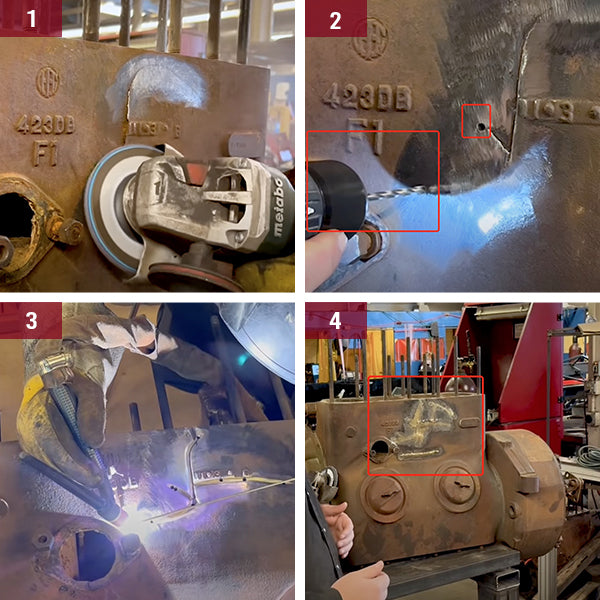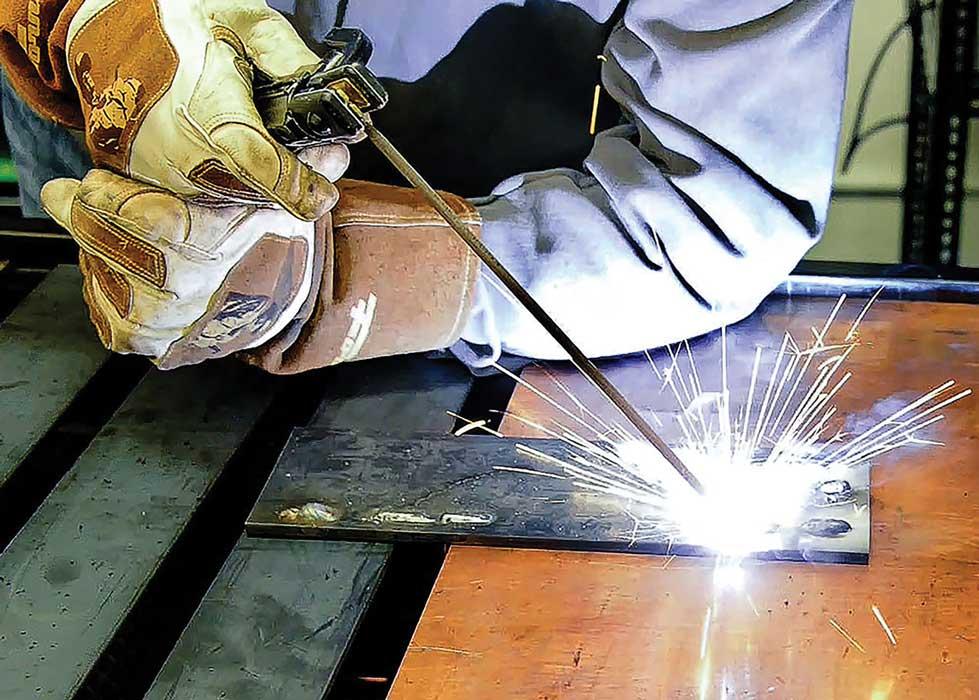All About Welding: Secret Insights Into Techniques and Best Practices for Success
Welding incorporates a range of techniques, each matched for specific products and applications. Comprehending these approaches, such as GMAW, SMAW, and TIG, is necessary for accomplishing suitable outcomes. In addition, the right devices and safety techniques can not be ignored. As prep work and fixing play vital functions in the welding process, mastering these aspects can greatly enhance the high quality of the final item. What are the crucial elements that ensure an effective weld?
Recognizing Different Welding Techniques
Welding methods incorporate a range of techniques, each suited to specific applications and materials. Among one of the most common methods are Gas Metal Arc Welding (GMAW), Shielded Steel Arc Welding (SMAW), and Tungsten Inert Gas Welding (TIG) GMAW, likewise called MIG welding, is preferred for its rate and convenience, making it suitable for thin products. SMAW, or stick welding, is favored for its simpleness and performance in outdoor settings, specifically with thicker steels. TIG welding offers accuracy and control, making it suitable for intricate work and non-ferrous steels (Montana Mobile Welding and Repair Fabrication). Each technique has its one-of-a-kind advantages and considerations, enabling welders to pick the best technique based on the project's needs, product kind, and preferred end results. Recognizing these strategies is necessary for successful welding
Essential Welding Equipment and Devices
While numerous welding strategies call for certain abilities, the best devices and devices are just as important for attaining high quality outcomes. Vital welding tools includes welding equipments, which vary depending upon the strategy-- such as MIG, TIG, or stick welding. Safety equipment, consisting of headgears, gloves, and aprons, guarantees safety and convenience throughout the process. On top of that, clamps and components assist secure materials in location, making certain accuracy in welds. Consumables like welding poles, cord, and protecting gas are additionally crucial components that influence the top quality of the weld. Furthermore, devices such as mills and cutters promote surface area preparation and post-weld completing, adding to an expert outcome. Investing in high-quality equipment eventually boosts the efficiency and effectiveness of welding tasks.
Safety Practices in Welding
Proper security techniques are important in the welding sector to safeguard workers from possible threats. Welders have to put on proper personal protective equipment (PPE), consisting of helmets with proper shading, handwear covers, and flame-resistant apparel. Adequate air flow is essential to lower exposure to harmful fumes and gases created during the welding process. Additionally, employees need to be educated in the correct handling of welding equipment to protect against crashes. Fire safety and security measures, such as maintaining combustible products far from the welding area and having fire extinguishers readily offered, are required. Routine inspections of tools and offices can help identify prospective dangers prior to they result in mishaps. By sticking to these security techniques, welders can develop a safer working environment and lessen threats connected with their profession.
Readying Materials for Welding
Preparing products for welding is an important action that significantly influences the top quality and honesty of the last product (Fabrication). Correct preparation involves cleansing the surface areas to eliminate pollutants such as oil, corrosion, and dust, which can compromise the weld. Strategies such as grinding, sanding, or utilizing solvents are generally employed to achieve a clean surface. Furthermore, guaranteeing that the materials fit together well is essential; gaps can bring about weak welds. It's additionally essential to take into account the placement and positioning of the components, as this will certainly affect the convenience of welding and the last result. Picking the suitable filler product and ensuring compatibility with the base steels is crucial for attaining strong, resilient welds.
Tips for Getting High-Quality Welds
Achieving high-quality welds needs attention to information and adherence to best techniques throughout the welding procedure. Proper joint preparation is necessary, making certain surface areas are cost-free and clean from contaminants. Picking the proper filler material and welding strategy based on the base metals is critical for excellent bonding. Maintaining regular travel speed and angle while welding can prevent issues and advertise harmony. In addition, regulating warmth input is essential; extreme warmth can bring about warping and damaged joints. Frequently checking the welds during the process permits prompt adjustments if required. Using suitable post-weld treatments, such as cleaning and stress alleviation, can enhance the longevity and stability of the weld, eventually making sure an effective outcome.
Troubleshooting Common Welding Issues
Welding commonly offers difficulties that can affect the top quality and honesty of the last product. Usual problems such as porosity, inconsistent weld beads, and getting too hot can arise, each calling for specific troubleshooting methods. Understanding these problems is vital for welders to enhance their abilities and accomplish excellent outcomes.
Porosity Issues Clarified
Porosity can usually be forgotten, it stays a critical concern in welding that can jeopardize the stability of an ended up item. Porosity refers to the existence of little gas pockets within the weld bead, which can compromise the joint and lead to early failing. This problem generally occurs from impurities, dampness, or incorrect securing gas insurance coverage throughout the welding process. To reduce porosity, welders must validate that the base products are completely dry and clean, use ideal securing gases, and preserve consistent welding specifications. Frequently checking the devices and environment can likewise help identify potential issues before they manifest in the weld. Dealing with porosity successfully is essential for attaining strong, resilient welds that satisfy high quality criteria.

Inconsistent Weld Beads
Irregular weld grains can significantly impact the top quality and stamina of a finished product. Numerous factors add to this issue, consisting of incorrect traveling rate, wrong amperage setups, and irregular electrode angles. When the welder relocates also rapidly, a grain may appear laser beam welding slim and do not have penetration, while moving also gradually can cause excessive buildup. Furthermore, using the incorrect amperage can result in either undercutting or excessive spatter, both of which compromise weld integrity. The welder's technique, such as irregular lantern activity, can likewise bring about unequal bead look. To mitigate these issues, welders must concentrate on maintaining consistent, controlled activities and making sure proper tools settings to achieve harmony in their welds. Consistency is vital to accomplishing dependable and solid welds.
Overheating and Bending Issues
Too much warmth throughout the welding procedure can lead to considerable getting too hot and contorting problems, impacting the architectural stability of the workpiece. These troubles commonly materialize as distortion, which can endanger placement and fit-up, making further setting up challenging. Factors adding to overheating include the option of welding criteria, such as voltage and travel speed, along with the kind of product being welded. To alleviate these issues, welders must keep consistent travel rate and ideal warm input while monitoring the work surface temperature level. In addition, preheating or post-weld warmth therapy can aid relieve tensions triggered by quick air conditioning - Montana Mobile Welding and Repair. Normal inspection and adherence to finest methods are essential in avoiding overheating and ensuring the durability and reliability of bonded frameworks
Often Asked Inquiries
What Are the Career Opportunities in the Welding Industry?
The welding market provides varied occupation chances, consisting of settings as welders, educators, engineers, and examiners. Professionals can operate in production, construction, aerospace, and vehicle sectors, profiting from strong demand and affordable wages in different duties.
Exactly How Can I Boost My Welding Speed Without Giving Up High Quality?
To boost welding rate without compromising top quality, one need to exercise efficient techniques, maintain devices, optimize setups, and improve hand-eye control. Routine training and looking for feedback can likewise significantly contribute to accomplishing much faster, premium welds.
What Certifications Are Available for Welders?
Many qualifications exist for welders, consisting of those from the American Welding Culture (AWS), the National Center for Construction Education and Research Study (NCCER), and numerous industry-specific organizations. These qualifications enhance employability and show ability efficiency.
How Does Welding Affect the Residences of Metals?
Welding affects the properties of steels by changing their microstructure, which can bring about changes in firmness, ductility, and toughness. Warmth input and cooling rates throughout the visit this site right here process substantially influence these material qualities.
Can I Weld Dissimilar Metals Together?
